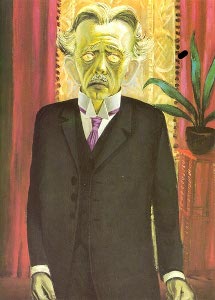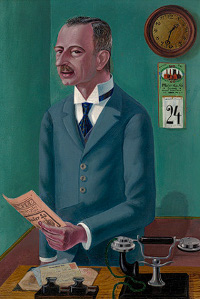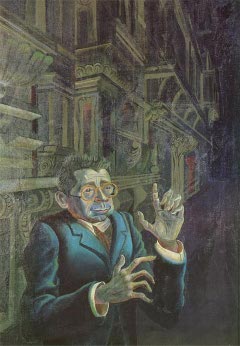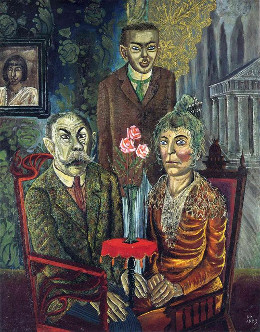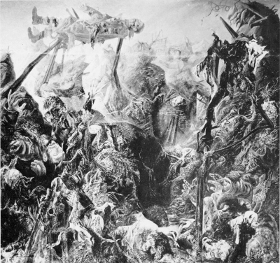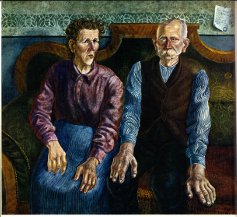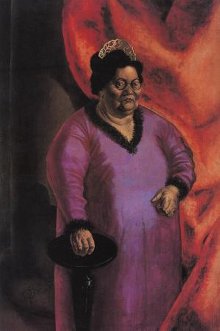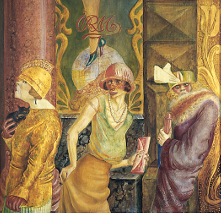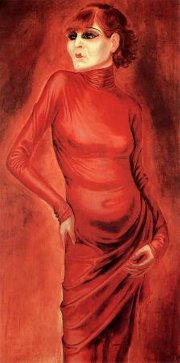Portrait of Dr. Heinrich Stadelmann
Year: 1922
Description: Dr. Heinrich Stadelmann was a clinincal psychologist and a specialist in nervous systems. His sessions often included hypnotic therapy. In this portrait he appears both mad and under the spell of his own hypnotic trance. His eyes bulge and glitter. His fists are clenched and his posture is tense. What demons lurk beneath that morbid exterior? It's as though Dix turned tables on the doctor released them with his own psychological examination.
Provenance: The Art Gallery of Ontario, Toronto
The Businessman Max Roesberg, Dresden
Year: 1922
Description: In many ways this was a typical piece from the period after the war, especially as an example of civilian motif. Roesberg stands in a sparse office surrounded by objects associated with his occupation. He is depicted in three-quarter view which was common in Dix's work from this period. Yet one is struck by a complete lack of movement. The lines and colors are static. The outlines of shadow are precise. This was an exact moment in time captured by the calendar, the clock on the wall and the artist who painted them.
Provenance: The Metropolitan Museum of Art
Portrait Of The Painter Adolf Uzarski
Year: 1923
Description: Adolf Uzarski was a German artist, illustrator and writer associated with the New Objectivity movement. In 1906, he moved to Düsseldorf where he enroled in the School of Arts and Crafts.
Like many young artists in Düsseldorf at the time, Uzarski spent a great deal of time in Johanna Ey's cafe. It was here that he met Otto Dix. Uzarski soon became one of the artists championed by Mother Ey. Otto Dix was another.
Uzarski was a handsome man whose attractiveness was lost by Dix's rendition. Here is rendered as a sort of subterranean troll with large hands and a greenish complexion.
Provenance: Kunstgalerie D�sseldorf
The Family of the Painter Adalbert Trillhaase
Year: 1923
Description: Adalbert Trillhaase was a sculptor and allegorical painter from Dusseldorf. He was one of the artists in the circle of Johanna Ey, a baker turned art dealer who nutured young artists from the Dusseldorf academy. It was at the academy where Trillhaase met Dix. His family sat for Dix in 1923.
Trillhaase's own style has been compared to the British artist and occultist Aleister Crowley. In 1931, both artists were shown in Karl Nierendorf's "The World Below." Otto Dix was also displayed in that exhibition. One of his contributions was The Family of the Painter Adalbert Trillhaase.
Provenance: Public Museum
- Staatsgalerie, Stuttgart, Germany
The Trench
Year: 1923
Description:
This was the painting that made Otto Dix famous. In 1931, Alfred H. Barr referred to it as "perhaps the most famous picture painted in post-war Europe. Presumably destroyed during the Nazi era, it receives far less attention now.
The artist began work on The Trench in 1920 while he was still in Dresden. It traveled with him to Dusseldorf where he completed the work in 1923. The painting depicts a German trench in the aftermath of an artillery assault. It is filled with mutilated bodies, fragments of skulls, torn limbs, shred intestines and tattered uniforms.
The controversy began that year when it was acquired by the Wallraf-Rchartz Museum in Cologne. Apart from its abhorrant depiction of war, the work drew controversy from the political right which claimed it dishonored the men of 1914. Since public money was used to acquire the painting the dispute was sharp and loud. There were few in Cologne without an opinion. It was finally settled in 1925, when The Trench was returned to Karl Neirendorf, Dix's dealer.
In the 1930s, The Trench was seized by the Nazis and included in their exhibitions of degenerate art. Nazi records indicate was it sold for $200.00 in 1940. It is presumed destroyed.
Provenance: Location Unknown
- Nazi Party (1940)
- Degenerate Art - Munich (1937)
- Degenerate Art - Frankfurt (1936)
- Degenerate Art - Rathaus Dresden (1933)
- Karl Neirendorf (1925)
- Wallraf-Richar
Parents of the Artist
Die Eltern des Künstlers II
Year: 1924
Description:
As the note behind them makes clear, Franz is now 62 and Louise is 61. Their working class status is quickly apparent, revealed by two sets of heavy hands with dirt under their nails.
Provenance: Sprengel Museum, Hanover
The Art Dealer Johanna Ey
Year: 1924
Description: This unlikeliest of art dealers was known as "Mother Ey" to the artists she nutured. After a failed marriage, Johanna Ey opened a bakery near the Düsseldorf Academy of Arts where she helped and encouraged young artists. The cafe exhibited their works.
Her foray into the art world was initiated by friendship. The artists who frequented her cafe needed recognition and money. She provided them wall space and credit. On occasion, she even darned their socks. She soon became an energetic proponent of Modernism and an important regional dealer.
In the midst of the Great War, she closed the bakery and opened a gallery. It was shut down in 1934 when the Nazis branded her artists "degenerates." According to art historian Sergiusz Michalsky, "Johanna Ey's portrait was painted more often than that of any other woman in Germany."
Provenance: Private collection
Three Prostitutes On The Street
Year: 1925
Description:
Three women ply their trade on the streets of post-War Berlin. Two are ladies of evening in search of customers. A third walks by with her nose in the air. She is married into money and enjoys the trappings of wealth.
The third "prostitute" carries a dog, a toy dog. It is a prop that points to her as a kept woman or, if you will, "a play thing."
The sex workers are depicted with a high level of self-confidence. They are forthright with regard to their profession while the woman with her nose aloft is less honest about hers....
Provenance: Private collection
Portrait of the Dancer Anita Berber
Year: 1925
Description: Raised by a grandmother in Dresden, she fled to Berlin at age 16 where she supported herself in caberets. By the end of the war, she was dancing nude and performing in films. She was notorious and always in the company of lovers of both sexes. She could often be seen in hotel lobbies naked apart from an sable wrap, a pet monkey and a silver brooch packed with cocaine. She died of tuberculosis in 1928.
Provenance: Staatsgalerie, Stuttgart
Portrait of the Lawyer Hugo Simons
Year: 1925
Description: In 1925, Hugo Simons won a lawsuit on Dix's behalf. The artist painted his portrait in a display of gratitude. He generally preferred to accentuate a subject's ungainly characteristics but this depiction was almost flattering. The pair maintained a friendship for the rest of their lives. When the Nuremberg Laws stripped him of citizenship, Simons fled Germany for Canada. He died in Montreal with Dix's portrait hanging on the wall opposite his bed.
Provenance: Montreal Fine Arts Museum
-
Björn Sjöling
-
http://radarman1946.tumblr.com/ Melvin
-
Alice Rohr
-
Richard Foran
-
Richard Foran
-
Richard von Bitter
-
Karl Gauss
